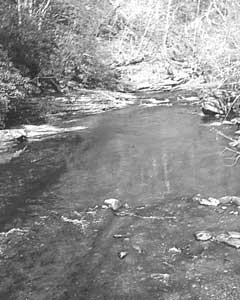
Big Snowbird Creek in Graham County stands out in an area noted for scenic trout streams.From its headwaters in the Snowbird Mountains near Cherokee County, Big Snowbird tumbles over a jumbled, unruly mass of boulders and rocks, forms three scenic waterfalls and passes through a remote and rugged section of the Nantahala National Forest on its way to Santeetlah Lake near Robbinsville.
The early Cherokee called this area “Titiyi,” the “snowbird place,” and some Cherokee found a haven here from the forced march called “The Trail of Tears.”
White pioneers prospected for minerals and established farmsteads here. Later, loggers came and stripped the land of its virgin chestnut, poplar and hemlock. Most of the scars have healed, and except for scattered campsites below the wild trout section of the stream, the area shows few signs of ever having been settled.
Big Snowbird is divided into three distinct fisheries. The lower section from an old logging railroad junction to the stream’s confluence with Santeetlah Lake is hatchery-supported waters.
Some sections of the lower stream pass through a mixture of private and public lands, but all but a few miles of the creek can be accessed either from a gravel road on the upper part or a paved road on the lower section.
Because of easy access, fishing pressure is heavy in spring and early summer. Despite the fishing pressure, large, deep pools in the lower section occasionally yield brown trout in the 16- to 22-inch range.
The wild trout section, from the Junction parking lot to the stream’s headwaters, covers approximately 12 miles, and the only access is by foot.
The middle section, from the Junction to Lower Falls, has good populations of rainbow and brown trout, with rainbows outnumbering browns abut 10 to 1.
With a high tree canopy and wide stream bed, this 5-mile section offers excellent fly-fishing. Numerous mid-sized rocks make hopping from run to run fairly easy. Huge boulders provide good cover for casting to the numerous deep pools, long runs, and pocket water. Rhododendron overhangs provide ideal hiding places for trout during hot weather, and if you skip a dry fly under those low branches, you’re almost certain to get a strike.
The gradient is moderate, and the stream, in many places, is shallow enough to wade. Because of the dense forest canopy, much of the creek is shaded, and wading can be hazardous in places because of mossy-slick rocks.
Brook-trout country begins at Lower Falls, and from there to the stream’s headwaters, a distance of about 7 miles, is some of the best brook trout fishing in the state.
From Lower Falls to Middle Falls, the stream is fed by numerous tributaries, providing a continuous supply of brook trout. The stream is surprisingly large below Middle Falls, but it gets smaller from Middle Falls to Upper Falls.
Brook trout at the upper section average about 7 inches, but anglers who frequently fish the stream say they’ve occasionally caught brook trout in the 12-inch range, especially from the waterfall-created pools.
The primary food source in the upper section of Snowbird is Mayflies, followed by caddisflies, with midges running a distant third. Mayflies also are the primary food source in the middle section, with caddisflies and midges about evenly divided.
Much of the stream can be accessed from a well-maintained trail from the Junction to Lower Falls. There are sections, though, where the stream is far below the trail. Once one reaches the stream, anglers usually remain in the water unless they want to crawl through thick rhododendron growth.
The trail narrows considerably from Middle Falls to Upper Falls, but there are plenty of open areas for camping.
The U.S. Forest Service maintains seven creekside camping sites along Big Snowbird Creek Road below the Junction. The sites are shaded and have picnic tables, fire rings and pit toilets. Since the sites are considered primitive, no camping fees are charged. Camping also is permitted anywhere in the upper section, but sites must be at least 50 feet from a stream.
The best way to fish Big Snowbird is to backpack in and spend a couple of days. That allows anglers to get into the best fishing.
From the junction of U.S. 129 and Joyce Kilmer Road (S.R 1127) in Robbinsville, go 3.3 miles to the junction with Massey Branch Road (S.R. 1116) and turn left. Bear left at the fork on S.R. 1127 and go to the junction with Little Snowbird Creek Road (S.R. 1115). Turn left and go 2.2 miles to the junction with Hard Slate Road (S.R. 1121). Take a sharp left at the junction and continue one mile to a bridge over Little Snowbird Creek Road. Turn right on Big Snowbird Creek Road (S.R. 1120), and go 6 miles to the Junction parking area.
From Robbinsville, the distance to the Junction is 13.7 miles.
For additional information about Big Snowbird Creek, contact the U.S. Forest Service, Cheoah District, telephone (828) 479-6431.




Be the first to comment